In “The Ballad of East and West,” British author Rudyard Kipling wrote what may be his most quoted line: “East is East and West is West, and never the twain shall meet.” Part of the line was borrowed by lyricist Ray Evans in an American song made popular by Dinah Shore in 1947. “East is East and West is West,” she sang, “and the wrong one I have chose.”
She preferred frilly eastern things like buttons and bows to western buckboards and buckskin.
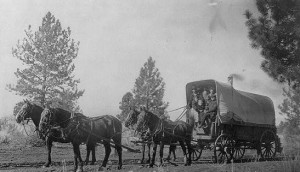
A family heads west in their Conestoga wagon that has all the conveniences! Note the chimney. (Library of Congress)
The East is East/West is West line fits the American experience. Whole families — not just young males — had responded eagerly to Indiana editor John B. L. Soule’s admonition of 1856 — later more famously used by New York publisher Horace Greeley: “Go west, young man, and grow up with the country.”
The Wild, Wild West
In internationally popular novels that would later be made into a genre of “western” movies, author Zane Grey depicted the American West as a rip-roaring, largely lawless world of sheriffs and outlaws, cowboys and “Injuns.”
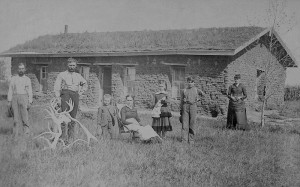
A family poses before their Custer County, Nebraska, sod house in 1886. A “soddie” was one of the few options on the plains, where trees were scarce. (Library of Congress)
“Back East” had been thoroughly explored, so waves of settlers moved west, built rough towns and sod houses “under starry skies above” on the western prairie.
So if you wanted to visit “the West” today, would you start at one of those “soddies”? Where does the West begin?
The Mississippi River, which snakes southward nearly all of the way from Canada to the Gulf of Mexico, once filled the bill… even though it’s only one-third of the way across America. Cross it, and you were mostly on your own. In 1803, outside St. Louis, Missouri, just across the wide Mississippi from the farms of southern Illinois, Meriwether Lewis and William Clark pitched the staging area of their epic exploration of the uncharted American Northwest.
Arc de St. Louis
In downtown St. Louis, today, the 17,000-ton, stainless-steel Gateway Arch stands as the symbolic “Gateway to the West.” The structure, designed by modernist architect Eero Saarinen in the 1960s, carries a clunky U.S. Park Service name — the Jefferson National Expansion Memorial — as a nod to the third president, Thomas Jefferson, who dispatched Lewis and Clark. And to the nation’s pell-mell westward expansion that ran right through St. Louis.
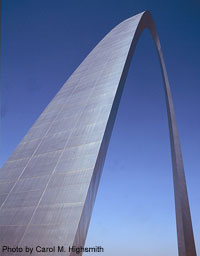
The Gateway Arch in St. Louis is not only the symbolic entryway to the West. It’s also a remarkable engineering wonder. (Carol M. Highsmith)
If you take the claustrophobic tram to the top of the Gateway Arch, 192 meters above the river, and peer westward through the window slits on a clear day, you can see 50 kilometers across Missouri.
But it sure doesn’t look like the West we’ve read about or seen in cowboy films. It looks like downtown St. Louis, and its suburbia. My friends in St. Louis agree that you’re seeing not the West but the Midwest out that window — a place that, most folks also agree, begins back east where the land flattens in Ohio.
America’s Breadbasket
“Middle America” rolls past St. Louis, right through all of Missouri and over the Missouri River into Kansas and Nebraska. There, somewhere, Midwest meets West. But where? Not in bustling Kansas City — the two Kansas Cities, actually: one in Missouri and one across the river in Kansas. They are no more “western” in look and feel than Chicago or Atlanta.
And even once you’re well into it, can Kansas be “western” if it’s full of corn in August, as reported in the song “A Wonderful Guy” from the “South Pacific” musical? A tornado in Dorothy’s dream swept her and her dog Toto from a dull Midwest-style Kansas farm to the fanciful land of the Wizard of Oz. As far as western Kansas, spurs and saddles aren’t in order when you’re standing in the middle of a forever-flat wheat field.
Yet Dodge City, the quintessential, rip-snorting Old West Town — home to legendary gunfighters Bat Masterson and Wyatt Earp — is a Kansas town.
Is that where the West begins?
Or is it up in the sweeping sandhills of western Nebraska, the narrow and oil-rich “panhandle” of western Oklahoma?
Or the rugged Badlands in the far reaches of South and North Dakota?
To Go West, Look South First
No, the West starts well below those places, down in Texas. Just ask a Texan if you don’t believe it!
Cowboy culture grew up on dusty Texas cattle “spreads” like the King Ranch, which happens to be larger than an entire U.S. state (Rhode Island). All across the dusty prairie, where tumbleweeds tumble, do-good Texas Rangers took the law into their own hands. America’s most enthusiastic “hanging judge,” Roy Bean, held court in a saloon there.
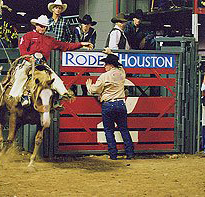
West enough for ya? (Carol M. Highsmith)
And the “Singing Cowboy,” Gene Autry, filmed “Round-Up Time in Texas” and many other movies in that “home on the range,” where the buffalo roamed and “the deer and the antelope play.”
Since Texas is such an enormous place — it’s almost 1,300 kilometers from Beaumont to El Paso, and only Alaska is larger among the states — we must narrow our search for the Start of the West.
Not ‘Big D,’ but in that Neighborhood
It’s that dot on the map to the west of sophisticated Dallas. Fort Worth is where the West begins!
We know this because Fort Worth says so. That’s its immodest slogan. Texans boast so openly that there’s a whole genre called “Texas brag.” Not only is Texas the biggest this, the best that, and the doggonedest something else, it’s even the only state that’s allowed to fly its flag at the same height at the U.S. colors.
Why? Any Texan will grandly tell you that, like the United States it eventually joined, it was once a sovereign republic, if only for about 10 years in the early 1800s.
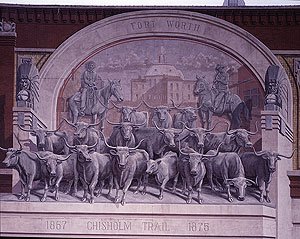
There's a Chisholm Trail sculpture right in downtown Fort Worth. (Carol M. Highsmith)
Fort Worth emerged from the prairie sod as a classic “cow town,” its stockyards an important stop on the cattle drives up the great Chisholm Trail. There, cowpokes shook off the dust after the long and grueling drives and went a bit wild. Shootouts were so common that they called Fort Worth’s prostitution district “Hell’s Half Acre.”
Fort Worth has funneled some of its considerable wealth into nonpareil art museums and shimmering performing-arts palaces, and Cowtown U.S.A. somehow grew into the nation’s 18th-largest city. It’s bigger than Boston, bigger than Detroit, bigger than Washington, D.C. Texas big!
But uptown cowboys in white and black Stetsons still holler at rodeos and ride mechanical bulls and line dance to the “Boot Scootin’ Boogie” at clubs like Billy Bob’s.
Ruler at the Ready?
So on your U.S. map, lightly draw a line straight north and south from Fort Worth and consider it the Start of the West. To the west of that Landphair Line, traffic speeds up and thins out; settlements grow so scarce that, from the air, we call it “flyover country”; cattle abound and rainfall is scarce; large lizards outnumber household pets; fences have barbs; barns, which are often flat and unpainted, shelter more hay or horses than milk cows; coal trains pulled by four or five locomotives stretch to the horizon; spittoons are not entirely out of fashion; beef and ground corn and hard whiskey are considered food groups; politics turn rightward; and “government” is an epithet.
I’m pretty sure Rudyard Kipling never made it past this Landphair Line that starts the West. But he might have liked that land had he done so. After all, he graduated from a school in Devonshire, England, that sits in a seaside village called — I’m not making this up — “Westward Ho!”
Did you read Zane Grey novels or other stories about the American West? Watch American “westerns”? Why do you think the Old West is so romanticized? Do you have any thoughts on the fate of American Indians, or Native Americans, as they are sometimes called? Write and tell me.
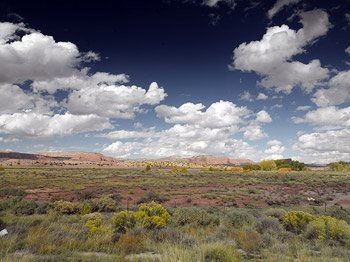
By the time you reach Northern Arizona, you're SURE you're in the West. (Carol M. Highsmith)
Ted's Wild Words
These are a few words from this posting that you may not know. Each time, I'll tell you a little about them and also place them into a cumulative archive of "Ted's Wild Words" in the right-hand column of the home page. Just click on it there, and if there's another word that you'd like me to explain, just ask!
Buckboard. An open, horse-drawn wagon with almost no amenities. Its driver sits in the open, on a flat, hard board, and it “bucks” plenty on unpaved roads.
Pell-mell. Confused, helter-skelter, in a big and disorderly rush. The term is derived from the French “pallemaille,” referring to a game involving a ball and mallet. The game was wild and confusing.
Sod houses. “Soddies,” as settlers on the Great Plains called these houses, were made from clumps of coarse bluestem grass in rich soil that were held together by their intricate web of roots and sliced into long strips with a “breaking plow.” Lacking enough trees for wood to build a complete house, pioneers stacked sod in rows to make the walls, then laid more strips atop precious boards that formed joists and the outlines of the attic. Finally, cloth was hung below the ceiling. It caught most, but not all, of the dirt that sifted down onto the family below.
Tumbleweed. A short Russian thistle shrub, common in many parts of the world, that dries and breaks away from its roots in autumn, then rolls like a ball in the wind across the plain. Tumbleweeds stick in barbed-wire fences and are sure to blow in front of your car when the dust kicks up, scaring you half to death. In one of their first hits, the Sons of the Pioneers western group sang that they belonged on the range, “drifting along with the tumbling tumbleweeds.”

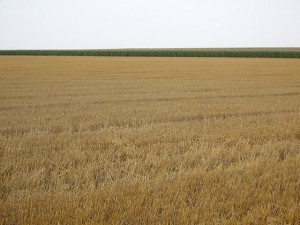
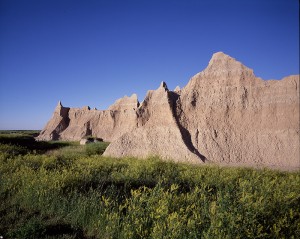

2 responses to “East is East, but Where’s the West?”
Today is the 100-year Anniversary of the “Xinhai revolution of China” .Let’s hope that the America people hold the flag of “Xinhai revolution”, sing the battle hymn of “the Democracy, the Civil right, the People livelihood”, and carry through the protest of “Occupy Wall Street” till the end.
Dear lidz,
I’m not sure what this comment has to do with the American West, but I didn’t see any harm in it.
Ted